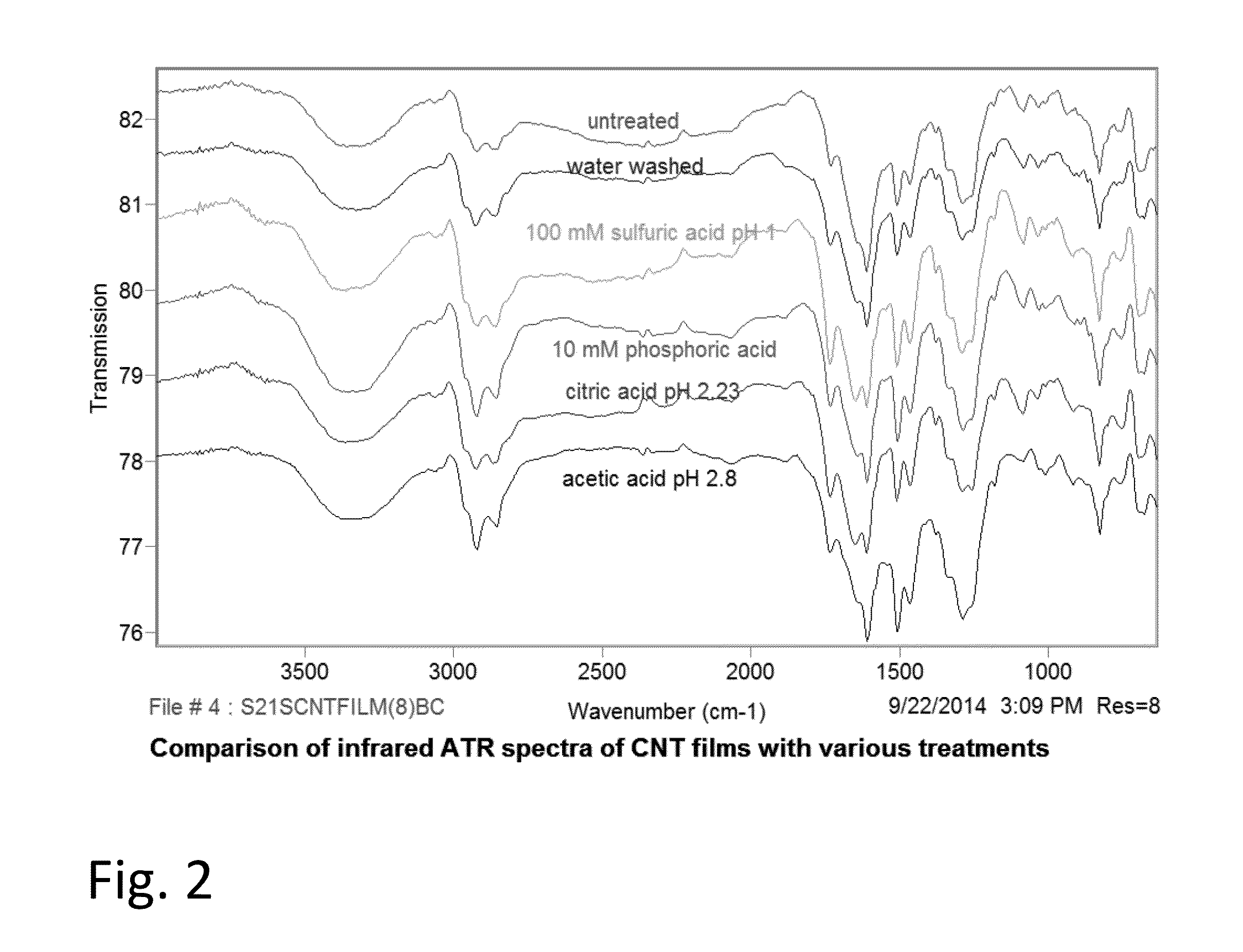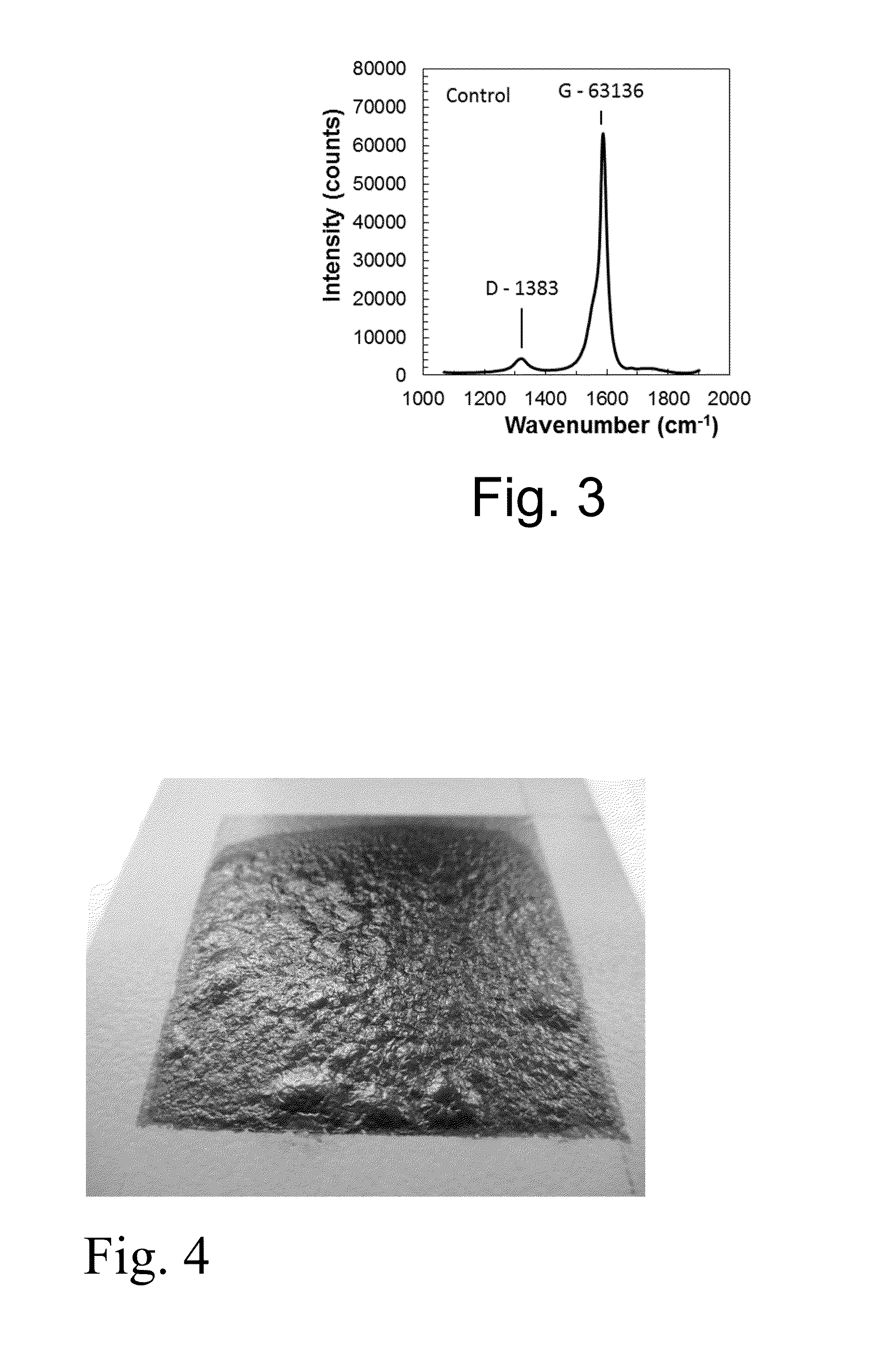Stabilization of carbon nanotube coatings to moisture
a carbon nanotube and stabilization technology, applied in the direction of non-metal conductors, cellulosic plastic layered products, conductors, etc., can solve the problems of change in conductivity or to lose mechanical and adhesive integrity, time-consuming and inefficient procedures, and increase the resistance of the material to moisture. , the effect of rapid wetting
- Summary
- Abstract
- Description
- Claims
- Application Information
AI Technical Summary
Benefits of technology
Problems solved by technology
Method used
Image
Examples
example 3
[0075](Diisocyanate+Pretreatment). A CNT-coated panel having an initial mass of 10.5237 g and resistance of 4.5Ω was submerged in phosphoric acid pH=1). For 10 min. No blistering of the CNT coating was observed. The panel was allowed to air dry and then vacuum dried, after which the mass was 10.5370 g and the resistance was 2.2 Ω. 260 μL of hexamethylene diisocyanate was added to 5 mL of dry toluene and mixed well. This solution was applied drop-wise to the panel and allowed to dry overnight, the subsequently rinsed with methanol. The panel was allowed to soak in water and then rinsed vigorously with water. No blistering was observed. The panel mass was 10.5312 g and the resistance 3.2 Ω.
example 4
[0077](Isobutylene). A panel with initial resistance of 1.1Ω was submerged into pH=2 phosphoric acid bath. No blistering was observed. The panel was removed and allowed to dry. The resistance was 0.9Ω. The isobutylene reactor was evacuated to 3 μm Hg and then pressurized with isobutylene to 10 PSI. The panel was allowed to dwell in the reactor over the weekend, after which the pressure inside the reactor was 6 PSI. The reactor was purged as described above, the panel was removed. The resistance was 0.9Ω and the coating appeared visually unchanged.
Conductivity, Surface and Wetting Properties
[0078]The subject invention creates films with good dispersion quality, surface finish, and low surface energy. The following examples indicate these properties.
[0079]The quality of the dispersion can be determined by casting a small droplet of CNT / HA dispersion (˜5 to 10 μL) onto a glass slide and allowing the water to evaporate. The resulting film should be dark and shiny, showing little to no c...
example 6
acid washed sample plateaus at ˜30 hours (tau), while the untreated Comparative Example never plateaus (tau is greater than the last time point taken).
[0112]For example, Example 6 increased resistance by 5.4% with the exposure. Comparative Example 6 increased resistance by 7% after 77 h and was not yet stabilized. The rate of resistance increase at this point was still 0.036 Ω / day (1.3% increase per day).
[0113]Bare (uncoated) samples also exhibit better stability to humidity and temperature fluctuations. Bare CNT films—both acid washed and untreated—were placed in 120° C. oven for 2 h and then removed to ambient. After 10 minutes, the resistance was recorded. Both samples showed an increase relative to the initial resistance. For the untreated sample, this change was greater than 400%, while for acid washed it was only 71%. As the samples were left in ambient, their resistance decreased to similar values. We believe that this change is associated with humidification of the sample, w...
PUM
| Property | Measurement | Unit |
|---|---|---|
| Temperature | aaaaa | aaaaa |
| Temperature | aaaaa | aaaaa |
| Fraction | aaaaa | aaaaa |
Abstract
Description
Claims
Application Information
 Login to View More
Login to View More - R&D
- Intellectual Property
- Life Sciences
- Materials
- Tech Scout
- Unparalleled Data Quality
- Higher Quality Content
- 60% Fewer Hallucinations
Browse by: Latest US Patents, China's latest patents, Technical Efficacy Thesaurus, Application Domain, Technology Topic, Popular Technical Reports.
© 2025 PatSnap. All rights reserved.Legal|Privacy policy|Modern Slavery Act Transparency Statement|Sitemap|About US| Contact US: help@patsnap.com



